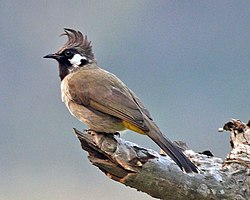Taxonomy and systematics
The genus Pycnonotus was introduced by the German zoologist Friedrich Boie in 1826 with the Cape bulbul as the type species. [1] The name of the genus combines the Ancient Greek words puknos "thick" or "compact" and -nōtos "-backed". [2]
The genus contains the following 31 species: [3]
In previous circumscriptions the genus Pycnonotus was considerably larger. Recent taxonomic revisions have seen many species transferred to other genera.
In 2010, eighteen former Pycnonotus species were reclassified into different genera, either directly from Pycnonotus or from the genus Andropadus , to which they had already been transferred by some authorities. These changes were as follows:
In 2020, a further 17 species were transferred to other genera: [3] [19]
Other former Pycnonotus species include:
This page is based on this
Wikipedia article Text is available under the
CC BY-SA 4.0 license; additional terms may apply.
Images, videos and audio are available under their respective licenses.



























